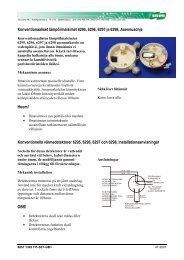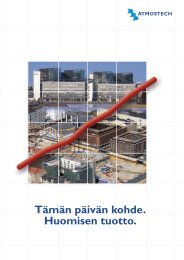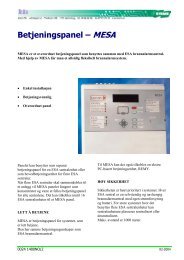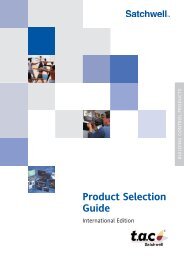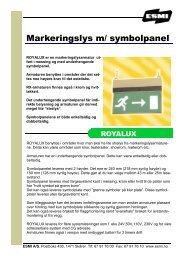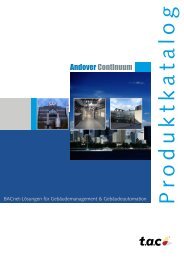MK-3000 Series, MK2-3000 Series, MK4-3000 Series
MK-3000 Series, MK2-3000 Series, MK4-3000 Series
MK-3000 Series, MK2-3000 Series, MK4-3000 Series
- TAGS
- series
- www.tac.com
You also want an ePaper? Increase the reach of your titles
YUMPU automatically turns print PDFs into web optimized ePapers that Google loves.
APPLICATION<br />
TAC<br />
1354 Clifford Avenue<br />
P. O. Box 2940<br />
Loves Park, IL 61132-2940<br />
www.tac.com<br />
Proportional pneumatic actuator with 8 in. 2 (52 cm 2 ) effective<br />
area used to control dampers, mixing boxes, air valves, etc.,<br />
in heating, ventilating and air conditioning systems,<br />
<strong>MK</strong>2-31X1 used for high temperatures.<br />
SPECIFICATIONS<br />
Construction:<br />
Housing, Die cast aluminum.<br />
Diaphragm, Beaded molded neoprene. <strong>MK</strong>2-31X1 only -<br />
Beaded molded silicone.<br />
Stroke: See Table 2.<br />
Start Point: Adjustable on most models ± 1 psi, see Table 2.<br />
Spring: Retracts actuator shaft on loss of air pressure.<br />
Maximum Air Pressure: 30 psig (207 kPa).<br />
Ambient Temperature Limits:<br />
Shipping, -40 to 160°F (-40 to 71°C).<br />
Operating, -20 to 160°F (-29 to 71°C).<br />
<strong>MK</strong>2-31X1 only,<br />
Shipping, -40 to 250°F (-40 to 121°C).<br />
Operating, -20 to 250°F (-29 to 121°C), for 30 minute<br />
exposure 450°F (232°C).<br />
Air Connections: 1/8” FNPT.<br />
Mounting: In any position. Mounting bracket (except<br />
<strong>MK</strong>-3300 <strong>Series</strong> end mounting) and connector for 5/16" (8<br />
mm) diameter push rod included with actuator.<br />
Dimensions: 12" high x 5-7/8" wide x 5-1/2" deep (305 mm<br />
x 143 mm x 140 mm)<br />
ACCESSORIES<br />
AK-42309-500 Positive positioner and linkage, do not use with<br />
<strong>MK</strong>2-3100 series<br />
AM-111 Crank arm for 5/16" diameter damper shaft<br />
AM-112 Crank arm for 3/8" diameter damper shaft<br />
AM-113 Crank arm for 1/2" diameter damper shaft<br />
AM-115 Crank arm for 7/16" diameter damper shaft<br />
AM-122 Linkage connector straight type<br />
AM-123 Damper clip<br />
AM-125 5/16" x 20" damper rod<br />
AM-125-048 5/16" x 48" damper rod<br />
AM-132 Ball joint connector<br />
AM-161-3 Damper linkage kit<br />
AM-301 90° mounting bracket for pivot mounting<br />
AM-530 Crank arm for 1/2" diameter damper shaft holes<br />
for 3-1/2" and 4-1/2" stroke<br />
AM-532 Bolt-on frame lug and damper blade clip kit<br />
AM-533 Actuator shaft extension<br />
AM-534 Pivot stud for pivot mounting<br />
AM-535 Clevis for pivot mounting<br />
AM-536 Mounting plates for pivot mounting on ducts or<br />
damper frame<br />
AM-545 Rod end connector for 5/16" (10 mm) dia. rods<br />
TOOL-95 Pneumatic calibration tool kit<br />
<strong>MK</strong>-<strong>3000</strong> <strong>Series</strong>, <strong>MK</strong>2-<strong>3000</strong><br />
<strong>Series</strong>, <strong>MK</strong>4-<strong>3000</strong> <strong>Series</strong><br />
Table-1 Nominal Damper Area For Proportional Control a<br />
Actuator Part<br />
Number<br />
<strong>MK</strong>-3101<br />
<strong>MK</strong>-3101-108<br />
<strong>MK</strong>2-3101<br />
<strong>MK</strong>4-3101<br />
<strong>MK</strong>-3111<br />
<strong>MK</strong>2-3111<br />
<strong>MK</strong>-3121-109<br />
<strong>MK</strong>-3121<br />
<strong>MK</strong>2-3121<br />
<strong>MK</strong>-3141<br />
<strong>MK</strong>4-3141<br />
<strong>MK</strong>-3151<br />
<strong>MK</strong>-3161b <strong>MK</strong>-3201<br />
<strong>MK</strong>-3211<br />
<strong>MK</strong>-3221<br />
<strong>MK</strong>-3311-109<br />
<strong>MK</strong>-3321-102<br />
<strong>MK</strong>-3801<br />
<strong>MK</strong>4-3801<br />
<strong>MK</strong>-3811<br />
<strong>MK</strong>-3821<br />
<strong>MK</strong>-3841<br />
<strong>MK</strong>4-3841<br />
<strong>MK</strong>4-3111c <strong>MK</strong>4-3811c <strong>MK</strong>4-3121d <strong>MK</strong>4-3821d Pneumatic Damper Actuators<br />
General Instructions<br />
Parallel Blades Opposed Blades<br />
ft 2 m 2 ft 2 m 2<br />
11.6 1.07 15 1.39<br />
23.2 2.15 30 2.79<br />
34.8 3.23 45 4.18<br />
a<br />
For two-position control use proportional rating of the same actuator with<br />
positive positioner. Damper ratings are nominal and based on standard<br />
(not low leakage) dampers at 1" (25.4 mm) W.C. static pressure and 2000<br />
fpm (10 m/s) velocity.<br />
b<br />
Requires 20 psi be available to the actuator.<br />
c<br />
Requires minimum 15 psi be available to the actuator.<br />
d<br />
Proportional control with positioner (8-13 spring, 20 psi supply).<br />
Printed in U.S.A. 9/06 © Copyright 2006 TAC All Rights Reserved. F-12586-9
Table-2 Specifications.<br />
Part Number<br />
Nominal<br />
Operating<br />
Range<br />
Starting<br />
Pressure<br />
Nominal<br />
Stroke a<br />
Return<br />
Stroke<br />
Based on<br />
1.5 psi<br />
(10 kPa)<br />
Pressure<br />
to<br />
Actuator<br />
Maximum Force b<br />
15 psi<br />
(103 kPa)<br />
Supply<br />
Dual Press.<br />
System<br />
Power Stroke<br />
15 psi<br />
(103 kPa)<br />
Supply<br />
Single<br />
Press.<br />
System d<br />
20 psi<br />
(138 kPa)<br />
Supply<br />
Single or<br />
Dual Press.<br />
System<br />
15 psi<br />
(103 kPa)<br />
Supply Dual<br />
Press.<br />
System<br />
Nominal Torque c<br />
Proportional Control b<br />
15 psi<br />
(103 kPa)<br />
Supply<br />
Single Press.<br />
System<br />
2 © Copyright 2006 TAC All Rights Reserved. F-12586-9<br />
20 psi<br />
(138 kPa)<br />
Supply<br />
Single or<br />
Dual Press.<br />
System d<br />
psig kPa psig kPa in. (mm) lb. N lb. N lb. N lb. N lb-in. N-m lb-in. N-m lb-in. N-m<br />
<strong>MK</strong>-3101-108 3-7.2 21-50 3 ± 1 21 ± 7<br />
3 (76)<br />
Adjustable<br />
2 to 4 (51<br />
to 102)<br />
12 53 50 226 62 276 102 454 18 2.03 18 2.03 18 2.03<br />
<strong>MK</strong>-3101<br />
<strong>MK</strong>2-3101<br />
3-8 21-55 3 ± 1 21 ± 7<br />
12 53 44 196 56 249 96 427 21 2.37 21 2.37 21 2.37<br />
<strong>MK</strong>4-3101<br />
3 1/2 (89)<br />
Adjustable<br />
2 to 4 (51<br />
to 102)<br />
e 3-8 21-55 3 ± 1 21 ± 7 12 53 44 196 56 249 96 427 21 2.37 21 2.37 21 2.37<br />
<strong>MK</strong>-3111<br />
<strong>MK</strong>2-3111<br />
5-10 34-69 5 ± 1 3 ± 7 28 125 28 125 40 178 80 356 21 2.37 21 2.37 21 2.37<br />
<strong>MK</strong>4-3111 5-10 34-69 5 ± 1 34 ± 7 28 125 28 125 40 178 80 356 49 5.54 49 5.54 49 5.54<br />
<strong>MK</strong>-3121<br />
<strong>MK</strong>-3121-109<br />
<strong>MK</strong>2-3121 e<br />
8-13 55-90 8 ± 1 55 ± 7 52 231 4 18 16 71 56 249 7 79 21 2.37 21 2.37<br />
<strong>MK</strong>4-3121e 8-13 55-90 8 ± 1 55 ± 7 52 231 4 18 16 71 56 249 7 79 28 3.16 91 10.28<br />
<strong>MK</strong>-3141<br />
<strong>MK</strong>4-3141 e 3-13 21-90<br />
<strong>MK</strong>-3151<br />
<strong>MK</strong>-3161<br />
3-6<br />
9-12<br />
3-6<br />
11-17<br />
21-41<br />
62-83<br />
21-41<br />
76-117<br />
3<br />
non-adj<br />
3-6<br />
3-6<br />
21<br />
non-adj<br />
21 to<br />
41<br />
21 to<br />
41<br />
2-3/4 (70)<br />
Adjustable<br />
2 to 2-3/4<br />
(51 to 70)<br />
12 53 4 18 16 71 56 249 7 79 21 2.37 21 2.37<br />
12 53 12 53 24 107 64 285 21 2.37 21 2.37 21 2.37<br />
12 53 0 0 0 0 24 107 0 0 0 0 21 2.37<br />
<strong>MK</strong>-3201 3-8 21-55 3 ± 1 21 ± 7 90 o<br />
12 53 44 196 56 249 96 427 21 2.37 21 2.37 21 2.37<br />
<strong>MK</strong>-3211 5-10 34-69 5 ± 1 34 ± 7<br />
Rotation<br />
Typical,<br />
Adjustable<br />
28 125 28 125 40 178 80 356 21 2.37 21 2.37 21 2.37<br />
<strong>MK</strong>-3221 8-13 55-90 8 ± 1 55 ± 7 1.2 to 4.4<br />
(30 to 111)<br />
52 231 4 18 16 71 56 249 7 .79 21 2.37 21 2.37<br />
<strong>MK</strong>-3311-109 5-10 34-69 5 ± 1 34 ± 7 3-1/2 (89)<br />
Adjustable<br />
28 125 28 125 40 178 80 356 21 2.37 21 2.37 21 2.37<br />
<strong>MK</strong>-3321-102 8-13 55-90 8 ± 1 55 ± 7 2 to 4 (51<br />
to 102)<br />
52 231 4 18 16 71 56 249 7 .79 21 2.37 21 2.37<br />
<strong>MK</strong>-3801<br />
<strong>MK</strong>4-3801e 3-8 21-55 3 ± 1 21 ± 7<br />
12 53 44 196 56 249 96 427 21 2.37 21 2.37 21 2.37<br />
<strong>MK</strong>-3811<br />
<strong>MK</strong>4-3811<br />
5-10<br />
5-10<br />
34-69<br />
34-69<br />
5 ± 1<br />
5 ± 1<br />
34 ± 1<br />
34 ± 1<br />
3-1/2 (89)<br />
Adjustable<br />
28<br />
28<br />
125<br />
125<br />
28<br />
28<br />
125<br />
125<br />
40<br />
40<br />
178<br />
178<br />
80<br />
80<br />
356<br />
356<br />
21<br />
49<br />
2.37<br />
5.54<br />
21<br />
49<br />
2.37<br />
5.54<br />
21<br />
49<br />
2.37<br />
5.54<br />
<strong>MK</strong>-3821<br />
<strong>MK</strong>4-3821<br />
8-3 55-90 8 ± 1 55 ± 1 2 to 4 (51<br />
to 102)<br />
52 231 4 18 16 71 56 249 7 79 21 2.37 21 2.37<br />
e<br />
8-13 55-90 8 ± 1 55 ± 1 52 231 4 18 16 71 56 249 7 79 28 3.16 91 10.28<br />
<strong>MK</strong>-3841<br />
<strong>MK</strong>4-3841e 3-13 21-90<br />
3<br />
non-adj<br />
21<br />
non-adj<br />
12 53 4 18 16 71 56 249 7 79 21 2.37 21 2.37<br />
a Factory setting required for published operating range.<br />
b Force and torques based on factory set stroke and starting pressure.<br />
c Nominal torque for actuators without positive positioner is based on 1.5 psi pressure change at the actuator.<br />
d Adjust pressure reducing valve so that listed pressures are available at the actuator.<br />
e Factory installed positive positioner (AK-42309-500) start point adjustable 2 to 10 psi with range adjustable 2 to 10 psi.
Figure-1 <strong>MK</strong>-3100 <strong>Series</strong> Dimensions. 1<br />
Figure-2 <strong>MK</strong>-3200 <strong>Series</strong> Dimensions.<br />
1. All dimensions shown in the Instruction Sheet are in inches.<br />
Mounting plate for <strong>MK</strong>-3101-108 and <strong>MK</strong>-3300-102<br />
<strong>Series</strong> Actuators<br />
Figure-3 <strong>MK</strong>-300 <strong>Series</strong> Dimensions 2 .<br />
Figure-4 <strong>MK</strong>-3800 <strong>Series</strong> Dimensions.<br />
2. Typical Model shown. Linkage, and air connection details may vary from<br />
Model to Model.<br />
F-12586-9 © Copyright 2006 TAC All Rights Reserved. 3
<strong>MK</strong>-3100 <strong>Series</strong> Typical Mounting<br />
Accessories Required for Mounting Per Figure 5<br />
1 — AM-113 Crank arm.<br />
1 — AM-122-0-0-2 or AM-132-0-0-2 ball joint.<br />
1 — AM-125 link rod 5/16-inch x 20 inches.<br />
To mount proceed as follows. Refer to Figure 5.<br />
1. Measure a minimum of 8 inches from damper shaft in the<br />
direction of actuator location.<br />
2. Hold actuator up to duct with actuator shaft approximately<br />
1-1/2 inches above (N.C.) or below (N.O.) damper shaft<br />
and mark mounting holes.<br />
3. With drill or punch, pierce holes marked in Step 2.<br />
4. Mount actuator to duct.<br />
5. Attach ball joint to crank arm at approximately 2-1/2<br />
inches from center of shaft hole.<br />
6. Attach crank arm to damper shaft at approximately 45°<br />
angle, from vertical, toward actuator with damper in the<br />
normal actuator retracted position.<br />
7. Connect actuator ball joint to crank arm ball joint with<br />
5/16-inch diameter rod. Cut off excess rod.<br />
8. Refer to Checkout.<br />
Figure-5 <strong>MK</strong>-3100 <strong>Series</strong> Typical Mounting.<br />
<strong>MK</strong>-3300 <strong>Series</strong> Typical Mounting<br />
Note: <strong>MK</strong>-3300 <strong>Series</strong> Models are designed for Mixing Box<br />
applications. Mounting, Linkage, and air connection details<br />
vary among Models. See Actuator Selection Sheet F-13795<br />
for more information.<br />
Accessories Required for Mounting Per Figure 8<br />
1 — AM-125 link rod 5/16-inch x 20 inches.<br />
1 — Connector as required for connection to driven device.<br />
To mount proceed as follows. Refer to Figures 6 and 8.<br />
1. Drill holes in mounting surface as shown in Figure 6.<br />
2. Mount actuator.<br />
3. Connect actuator.<br />
4. Refer to Checkout.<br />
Figure-6<br />
<strong>MK</strong>-3200 <strong>Series</strong> Typical Mounting<br />
Accessories Required for Mounting Per Figure 7<br />
2 — AM-113 crank arm.<br />
2 — AM-122-0-0-2 or AM-132-0-0-2 ball joint.<br />
1 — AM-125 link rod 5/16-inch x 20 inches.<br />
To mount proceed as follows. Refer to Figure 7.<br />
1. Locate actuator on a surface perpendicular to the damper<br />
shaft, with the actuator rotary shaft approximately in line<br />
with the damper shaft.<br />
2. Hold actuator up to duct and mark mounting holes.<br />
3. With drill or punch, pierce holes marked in Step 2.<br />
4. Mount actuator to duct.<br />
5. Attach crank arm to actuator shaft at approximately 45°<br />
angle.<br />
6. Attach ball joint to crank at approximately 2-1/2 inches<br />
from center of shaft hole.<br />
7. Attach crank arm to damper shaft an approximately 45°<br />
angle, from vertical, toward actuator with damper in the<br />
normal actuator retracted position.<br />
8. Attach ball joint to crank arm at approximately 2-1/2<br />
inches from center of shaft.<br />
9. Connect actuator ball joint to crank arm ball joint with<br />
5-1/6-inch diameter rod. Cut off excess rod.<br />
10. Refer to Checkout.<br />
Figure-7 <strong>MK</strong>-3200 <strong>Series</strong> Typical Mounting.<br />
4 © Copyright 2006 TAC All Rights Reserved. F-12586-9
Figure-8 <strong>MK</strong>-3300 Typical Mounting.<br />
<strong>MK</strong>-3800 <strong>Series</strong> Typical Mounting<br />
Accessories Required for Mounting of Actuator Per<br />
Figure 9 through 11<br />
1— AM-532 bolt-on frame bracket kit.<br />
Note: Bracket kit includes the frame bracket, leaf connector,<br />
and necessary screws or bolts and nuts.<br />
To install the actuator proceed as follows:<br />
1. Prepare the damper by drilling necessary holes, etc. See<br />
Figures 11 and 15 for bolt-on bracket.<br />
2. Attach bracket and leaf connector to damper.<br />
3. Attach actuator mounting plate to damper bracket.<br />
4. Install pivot stud to actuator mounting plate.<br />
5. Install actuator to pivot stud and connect clevis to blade<br />
connector.<br />
Note: Adjust clevis as needed to align clevis and leaf<br />
connector.<br />
Figure-9 <strong>MK</strong>-3800 <strong>Series</strong> Typical Mounting, Normally Open.<br />
Figure-10 <strong>MK</strong>-3800 <strong>Series</strong> Typical Mounting,<br />
Normally Closed.<br />
Preparing Damper for Frame Mounting of Actuator<br />
Refer to Figures 11 and 15 for required holes, etc. for AM-532.<br />
Figure-11 Typical Bolt-On Bracket Mounting.<br />
Accessories Required for Mounting of Actuator Per<br />
Figure 12<br />
1 — AM-530 crank arm.<br />
To install proceed as follows:<br />
1. Attach mounting plate to duct or wall with damper shaft<br />
protruding through locator hole in mounting plate. If this is<br />
not possible, additional shaft extensions may be used to<br />
allow locating the actuator farther from the damper shaft.<br />
Each extension provides 4 inches of extension to the<br />
actuator shaft and may be used in multiples.<br />
2. Install the pivot stud to the mounting plate.<br />
3. Install actuator on pivot stud.<br />
4. Install crank arm on damper shaft at approximately 45°<br />
angle from vertical toward actuator.<br />
F-12586-9 © Copyright 2006 TAC All Rights Reserved. 5
Note: Figure 12 shows position for normally closed.<br />
5. Manually position damper to full retracted actuator<br />
position and tighten crank arm in position described in<br />
Step 4.<br />
6. Connect clevis to crank arm in hole closest to damper<br />
shaft. If necessary adjust clevis and/or extensions.<br />
7. Refer to Checkout.<br />
Figure-14 <strong>MK</strong>-3800 <strong>Series</strong> Clevis.<br />
Figure-13 Mk-3800 <strong>Series</strong> Mounting Plate.<br />
Figure-12 <strong>MK</strong>-3800 Typical External Pivot Mounted.<br />
Figure-15 AM-532 Bolt-On Frame Bracket.<br />
6 © Copyright 2006 TAC All Rights Reserved. F-12586-9
CHECKOUT<br />
After installation, the actuator should be checked to insure<br />
proper damper operation. To check the actuator and linkage,<br />
proceed as follows:<br />
1. Check the linkage with the actuator in the retracted<br />
position for proper return force. The actuator should be<br />
linked so that on a normally closed application, the damper<br />
is closed with no more than 1/16-inch compression of the<br />
spring. (The actuator shaft would return an additional<br />
1/16-inch if the linkage were disconnected.) For a normally<br />
open application, the actuator should be linked with the<br />
actuator fully retracted.<br />
2. Apply air pressure to the actuator or pilot port of a<br />
positioner and check the linkage as follows. On a<br />
normally closed application, the damper should be just<br />
full open when the actuator piston reaches the stops in<br />
the actuator. On a normally open application, the damper<br />
should reach the closed position with no more than<br />
1/16-inch stroke remaining to reach the actuator stops.<br />
3. The above can be obtained through adjustment of the ball<br />
joint in the crank arms or by adjustment of the actuator<br />
stops. The amount of thread engagement of the actuator<br />
ball joint or extension shaft may also be used to assist in<br />
proper linking.<br />
Connection of Air Line: On pivot mounting arrangements,<br />
Figures 9, 10 and 12, control air lines MUST be terminated at<br />
the actuator with at least 6 inches of flexible tubing to allow for<br />
pivoting of the actuator. On mounting arrangements, Figures<br />
5, 7 and 8, control air lines may be connected directly with<br />
either copper or plastic tubing, as required by application.<br />
Caution: On <strong>MK</strong>2-31X1 <strong>Series</strong>, metal connectors and tubing<br />
must be used.<br />
Adjustable Starting Pressure: Actuators are available with<br />
adjustable starting pressure. To adjust the starting pressure,<br />
turn adjusting nut supporting the spring clockwise to increase<br />
and counterclockwise to decrease the starting pressure. Each<br />
rotation of the adjusting nut changes the starting pressure .04<br />
psi (.28 kPa).<br />
Adjustable Stroke Length: Stroke length is determined by<br />
the two stops located on either side of the actuator. Stops are<br />
set for 3-1/2-inch stroke. mark this point and measure toward<br />
the diaphragm end of the actuator to reduce the stroke or<br />
away from the diaphragm end to increase the stroke.<br />
Maximum stroke length is 4 inches. By increasing the stroke<br />
length, the force available to resist an opposing force is<br />
decreased while decreasing the stroke length increases this<br />
force.<br />
Diaphragm Replacement: If the actuator diaphragm should<br />
leak, it may easily be replaced by removing the four screws<br />
holding the top power housing. Make sure that shaft swivel<br />
joint is in place on the end of the shaft. Remove the screws<br />
and old diaphragm. Roll the new diaphragm inside out and<br />
install over the piston making sure the circular bead is facing<br />
up. Put the top power housing back in place making sure the<br />
bead on the diaphragm is in the housing groove and the screw<br />
holes are lined up. Tighten housing screws.<br />
UNITS WITH FACTORY MOUNTED<br />
POSITIVE POSITIONERS<br />
Figure-16 Typical Factory Mounted Positioner.<br />
For Actuators with Positioners:<br />
Note: If actuator is frame pivot mounted, the actuator must<br />
be mounted to the left-hand frame. If actuator is mounted<br />
external, Figure 12 must be on right-hand side of duct.<br />
Install fittings required in Ports 2 and 3.<br />
ADJUSTMENTS<br />
Refer to Figure 16.<br />
Range Adjustment: Adjustable 2 to 10 psig (14 to 69 kPa).<br />
Factory set at 5 psig (34 kPa). Range is the pressure change<br />
required to produce full actuator stroke.<br />
If adjustment is required (see Figure 16), with a small<br />
screwdriver loosen screw on range slider approximately 1/2<br />
turn.<br />
Move the graduated range slider until desired pressure mark<br />
lines up with center of screw and tighten screw.<br />
Start Point: Adjustable 2 to 10 psig (14 to 69 kPa). Start point<br />
is the pressure at which the actuator just begins to extend.<br />
See Figure 16.<br />
Connect main air supply to Port 3 and a variable air supply to<br />
Port 2.<br />
1. Adjust variable air supply on Port 2 to desired start point<br />
pressure.<br />
2. Adjust the start point screw with small screwdriver until<br />
actuator just starts to extend.<br />
3. Gradually raise pressure on Port 2 until actuator is fully<br />
extended, and readjust range slider to obtain desired<br />
range if further adjustment is necessary.<br />
4. Remove variable air supply from Port 2 and connect to<br />
controller output.<br />
F-12586-9 © Copyright 2006 TAC All Rights Reserved. 7
Copyright 2006, TAC<br />
All brand names, trademarks and registered<br />
trademarks are the property of their respective<br />
owners. Information contained within this<br />
document is subject to change without notice.<br />
F-12586-9<br />
Note: If slave damper actuators<br />
are to be controlled, tee into the<br />
tubing from Port 1 to the<br />
actuators. All dampers must be<br />
mechanically interconnected.<br />
Figure-17 Typical Piping Diagram with Factory Mounted Positive<br />
Positioner.<br />
TAC<br />
1354 Clifford Avenue<br />
P.O. Box 2940<br />
Loves Park, IL 61132-2940<br />
www.tac.com



